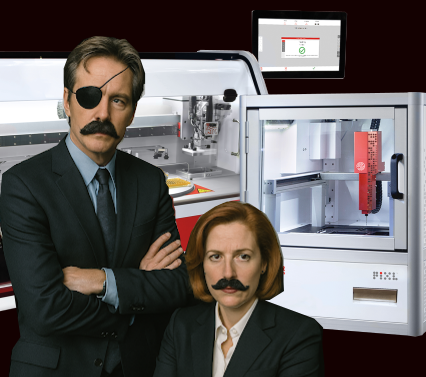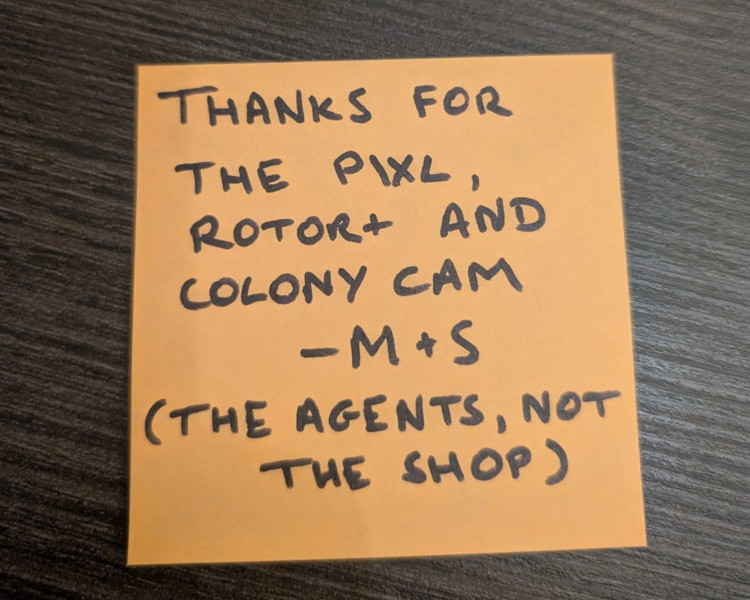- Products
- Resources
Using PIXL & ROTOR to Prevent an Alien Takeover (kind of)
David Kirk1, Agents Fox Moulder2 and Dr D’na Skull-y2, Dr Suzanne McCusker3, Dr Chloe Uyl4,5, and Dr Eric Brown6
1Local nutcase, 2Faux Biology Institute (FBI), 3Australian Human Microbiome Biobank, 4University of Kent (formerly), 5Quadram Institute (currently), 6McMaster University
FBI Microbial Xenobiology Unit
The FBI-MXU’s remit is simple: Investigate life from other worlds.
“The truth is out there.” – Agent Moulder
“Or in here… It’s definitely somewhere.” – Dr Skull-y

Agents Fox Moulder & D’na Skull-y with PIXL and ROTOR+
(Identities have been obscured with cutting-edge AI to maintain secrecy)
The Challenge: Microbes from Beyond the Moon
The following case file relates to recently declassified events. Names have been changed to protect the innocent.
A meteor fell from the sky on the night of October 31st 2024, crashing into a cornfield.
But when the local farmer and his family began to exhibit strange symptoms, Agents Moulder and Skull-y were dispatched to investigate. Agent Moulder explains:
“It’s a classic zombie case – shambling walk, groaning – but there was one twist: The farmer kept trying to feed everyone corn from the meteor impact site. And he kept shouting ‘GRRRAAAIIINNNSSSS’… Weird, right?”
Dr Skull-y adds:
“We quickly realised he was infected by something from the meteor. We just had to figure out what it was, based on all the samples we collected.”
The Solution: Isolating, Arraying, and Screening with Robots
Agents Moulder and Skull-y wiped our memories at this point.
We woke up missing a PIXL, ROTOR+ and ColonyCam, and found this note:

Based on past experiences with other researchers, here’s how we imagine they used our robots to save the world.
Picking through samples with PIXL
Finding an alien microbe among thousands of Earth species is like finding a needle in a haystack. Even with selective plates, hundreds of colonies must be assessed.
Similarly, the Australian Human Microbiome Bank uses our automated colony picker, PIXL, to pick colonies from samples at speed – within five minutes of sample collection – all inside an anaerobic chamber.
“PIXL can pick an entire 96-well plate of colonies into new media in minutes, take photos of the plate, and take photos of each individual colony on the plate. Doing this by hand would take nearly five minutes per bacterial colony, not per plate. That’s pretty impressive.” – Dr Suzanne McCusker
Phenotypic Screening with PIXL, ROTOR+ and ColonyCam
With the PIXL’s precision, colonies can be arrayed on plates. Then, our ROTOR+ can replicate these arrays for further precision screening of alien microbial phenotypes.
That’s just how Dr Chloe Uyl (then a PhD student at the University of Kent) examined strains of the industrially important S. stipitis isolates in arrays of 384 colonies under different growth conditions.
She also used ColonyCam to image plates grown in different conditions. By measuring colony size in pixels, she had an indicator for growth rate in those diverse environments.
Finding a Cure with ROTOR+
Killing an invasive alien microbe sounds pretty difficult, especially because science is often so meticulous and (dare we say it?) slow.
That frustration is shared by our colleagues in Antimicrobial Resistance (AMR) research – let’s face it, antimicrobial resistance is a very real threat to humanity.
Eric Brown’s group at the Michael DeGroote Institute for Infectious Disease Research at McMaster University is using our ROTOR+ to speed up AMR research.
“There is no other instrument out there that can pin colonies like this thing can pin, which allows us to do chemical genomics just like nobody’s business… We’re monitoring the growth of those pinned strains at as high as 6144 density using the ROTOR+.”
Outcomes: Protecting Earth from Alien Zombie Microbes
Presumably, by using Singer’s PIXL, ROTOR+, and ColonyCam, Agents Moulder and Skull-y could identify the alien microbe and how to inhibit its growth:
- Isolate and catalogue thousands of colonies of diverse microbes from environmental and biological samples.
- Array and replica plate arrays of colonies onto plates for precision screening.
- Examine thousands of colonies per plate for abnormal and reduced growth.
Happy Hallowe’en! 🎃
Smash your bottlenecks with user-friendly lab automation
Looking for a high throughput screening solution capable
of getting you results ludicrously faster?